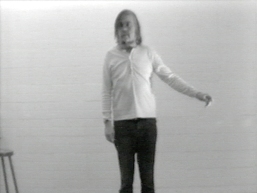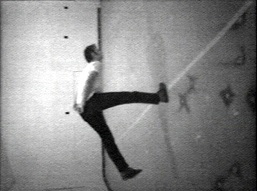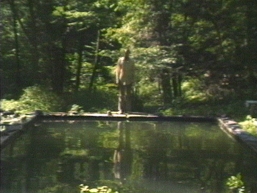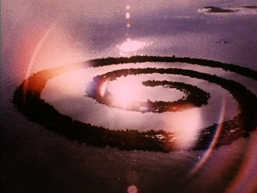Waiting to See
As the story is told, the first work of video art was created on October 4th, 1965, when Nam June Paik used a Sony Portapak CV-2400 to film Pope Paul IV’s motorcade from a Manhattan taxi, and showed the video at the Cafe à GoGo that evening. Fast forward to 2007, when media artist Tom Sherman noted that in 1965 the CV-2400 wasn’t yet available, and the earlier Sony CV-2000 wasn’t portable. Was Paik’s apocryphal story merely a Fluxus joke? The tape has disappeared, leaving only a grin.
None of Paik’s work appears in the sprawling MOMAT “Waiting for Video” exhibition, though it does not leave the visitor with a sense of dissatisfaction for all that. Bringing together both historical and contemporary works, the show is organized, first, to highlight the ambitions of some of the earliest video works by contextualizing them in artistic developments of the period, especially Postminimalism. Second, it juxtaposes contemporary video works with these early explorations, to illuminate the latent potential of media arts across a 45-year period. Here, curator Kenjin Miwa proposes that video (Latin for “I see”) should be understood in its broadest sense, not merely as the index of a specific medium, as the technology that supports television – but as a modality of seeing, one that touches upon a fundamental question of art. In this spirit, the show considers both film and video works, though specifically by artists of the plastic arts.


Rather than offering a straightforward survey of the history of video art, the show focuses on the period around 1970, to explore why painters and sculptors began to use film and video as a means to expand their expressive possibilities. The curatorial decision to focus on the axis between film, video, and the plastic arts accounts for the omission of works by artists like Paik, Takahiko Iimura, and Toshio Matsumoto. While many of the artists represented in “Waiting for Video” were based in New York, works by Japanese artists such as Hitoshi Nomura, Saburo Muraoka, Tatsuo Kawaguchi underscore that this alignment of the plastic and electronic arts around 1970 was a worldwide phenomenon. Thus, the exhibition focuses less on video per se, and more on clarifying the new modes of seeing and the expressive potential of film/video, both past and future.
The exhibition is organized into five “chapters” or perspectives: (1) Mirror and Reflection; (2) the Dematerialization of Art; (3) Body/Object(ive)/Medium; (4) Expanded Frame: Time and Space; and (5) Site. The chapters are not chronological, though the later ones do include more contemporary works. The first, “Mirror and Reflection”, begins with Warhol’s ‘Outer and Inner Space’ (1965), a thirty-three minute film/video portrait of Edie Sedgwick. With a total of four simultaneous images of Sedgwick on two split screens, the relative calm of her video presence collides with the palpable unease of her ad lib film performance. If “Waiting for Video” begins with Warhol, not Paik, because he more consistently crossed the internal boundaries of artistic fields, it is more remarkable how Warhol zeroed in on one of the early concerns of much video art: the relationship between the self in front of the camera and the self displayed on the monitor.


As Rosalind Krauss suggests, we may discern a shift in art produced around 1970, from a focus on the work as a closed system to one understood more explicitly as a relationship between work and spectator. This is certainly manifest in works that explore the feedback function. In addition to Warhol’s film/video-portrait of Sedgwick, it is clear that Vito Acconci’s ‘Centers’, Lynda Benglis’ ‘Now’, and Richard Serra and Nancy Holt’s ‘Boomerang’ all give weight to Krauss’ hypothesis that “the medium of video is narcissism”. Noting the tendency of early video pieces to focus on the human face, and how these artists seem drawn to conditions of self-regard, Krauss argues that many of these works convey the sense of a “collapsed present”. Insofar as it is joined with the inwardness of the narcissistic gaze, video serves to flatten the temporal dimension of what is normally understood as a time-based medium. In the early video works of John Baldessari and Bruce Nauman, we find this expressed as a particular interest in repetitive processes. Phrases, movements, and gestures are simply repeated until the tape runs out. Likewise in Serra’s ‘Hand Catching Lead’ and ‘Color Aid’ there is no narrative arc, no particular beginning or end.
Given the richness and sheer variety of works on display in this exhibition, Krauss’ 1976 hypothesis seems, in retrospect, perhaps more hypothetical. Bill Viola’s ‘The Reflecting Pool’ and Robert Smithson’s ‘Spiral Jetty’, in particular, are both powerful reminders that film/video have just as easily been used to expand our perception of time and nature. If anything, the master trope of this ambitious and greatly rewarding exhibition is, as Miwa suggests, expansiveness.
M. Downing Roberts
M. Downing Roberts



